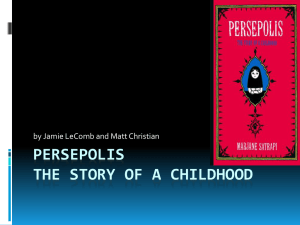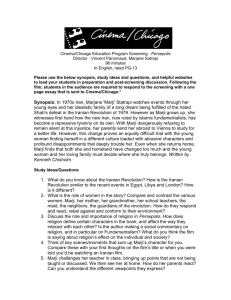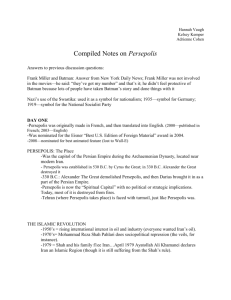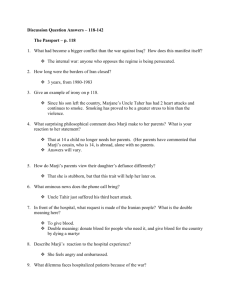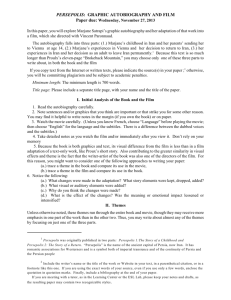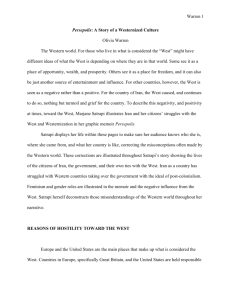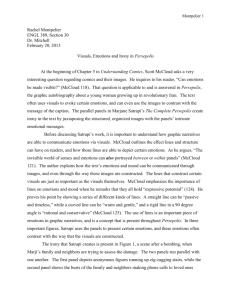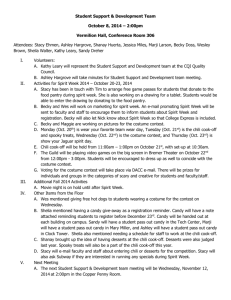Persepolis Study Guide: Questions & Analysis
advertisement
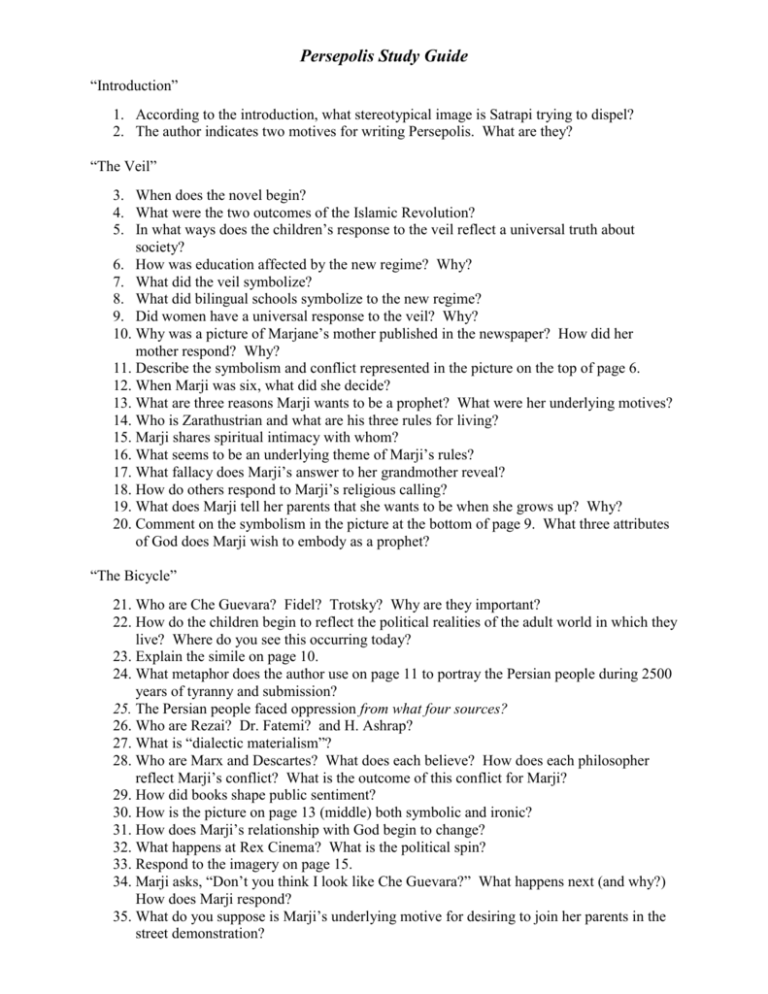
Persepolis Study Guide “Introduction” 1. According to the introduction, what stereotypical image is Satrapi trying to dispel? 2. The author indicates two motives for writing Persepolis. What are they? “The Veil” 3. When does the novel begin? 4. What were the two outcomes of the Islamic Revolution? 5. In what ways does the children’s response to the veil reflect a universal truth about society? 6. How was education affected by the new regime? Why? 7. What did the veil symbolize? 8. What did bilingual schools symbolize to the new regime? 9. Did women have a universal response to the veil? Why? 10. Why was a picture of Marjane’s mother published in the newspaper? How did her mother respond? Why? 11. Describe the symbolism and conflict represented in the picture on the top of page 6. 12. When Marji was six, what did she decide? 13. What are three reasons Marji wants to be a prophet? What were her underlying motives? 14. Who is Zarathustrian and what are his three rules for living? 15. Marji shares spiritual intimacy with whom? 16. What seems to be an underlying theme of Marji’s rules? 17. What fallacy does Marji’s answer to her grandmother reveal? 18. How do others respond to Marji’s religious calling? 19. What does Marji tell her parents that she wants to be when she grows up? Why? 20. Comment on the symbolism in the picture at the bottom of page 9. What three attributes of God does Marji wish to embody as a prophet? “The Bicycle” 21. Who are Che Guevara? Fidel? Trotsky? Why are they important? 22. How do the children begin to reflect the political realities of the adult world in which they live? Where do you see this occurring today? 23. Explain the simile on page 10. 24. What metaphor does the author use on page 11 to portray the Persian people during 2500 years of tyranny and submission? 25. The Persian people faced oppression from what four sources? 26. Who are Rezai? Dr. Fatemi? and H. Ashrap? 27. What is “dialectic materialism”? 28. Who are Marx and Descartes? What does each believe? How does each philosopher reflect Marji’s conflict? What is the outcome of this conflict for Marji? 29. How did books shape public sentiment? 30. How is the picture on page 13 (middle) both symbolic and ironic? 31. How does Marji’s relationship with God begin to change? 32. What happens at Rex Cinema? What is the political spin? 33. Respond to the imagery on page 15. 34. Marji asks, “Don’t you think I look like Che Guevara?” What happens next (and why?) How does Marji respond? 35. What do you suppose is Marji’s underlying motive for desiring to join her parents in the street demonstration? Persepolis Study Guide “The Water Cell” 36. Comment on the illustrations used to portray the demonstrations on page 18. 37. Why do Marji’s parents find her request to play Monopoly humorous? 38. According to Marji, how was a king chosen? What was her rationale? What is her father’s reaction? Why? 39. What were two contrasting views of the Republican ideal? 40. How did Reza, the father of the Shah, differ from Gandhi and Ataturk? 41. What was Reza’s original political motive? What trade-off does he make? Why? 42. What is a puppet government? In such a system, who seemed to be the real emperor of Persia? Give another example of a puppet nation. 43. Who does Marji learn was the emperor overthrown by Reza? How does this add to the conflict? 44. Comment on the image at the bottom of page 22. What change does it reflect? 45. What four things happened to the emperor’s family, and any who opposed the new government, when he was deposed by Reza? In what other book from this class did people face a similar fate? Where else has this practice occurred in recent history? 46. What new government role did Marji’s grandfather accept? What did he now study? Why? 47. What does Marji’s mother reveal in a flashback? Her husband responds by saying, “That time is past.” What do you think? 48. Why does God return after a long absence? “Persepolis” 49. How does Marji’s grandmother initially respond to questions about the past? 50. What are the strengths and limitations of using the graphic cartoon to tell the story? 51. How did the Shah’s rule compare to Reza’s? 52. How is the image of the Shah on the bottom of page 27 both symbolic and ironic? 53. Who was Cyrus the Great? Why was he so important? 54. What did Marji’s father do every day that makes her mother so nervous? Why is this activity strictly forbidden? 55. Ironically, what happens when a second dead man is carried out on a stretcher during a demonstration? 56. What happens next that surprises Marji and amuses her family? What do the widow’s actions show about the Persian people? “The Letter” 57. Who was Ali Ashraf Davishian? What was his favorite subject matter? 58. What causes Marji to feel so ashamed? Why? How is this realization connected to the revolution? 59. Who is Mehri? How does she come to join Marji’s family? How does Marji view her? How does Mehri view Marji? 60. What did Marji do for six months to help Mehri? Why? 61. How did news of Mehri’s clandestine affair reach Marji’s father? What was the outcome? Why? 62. What is Marji’s reaction to the break-up? 63. What happened on Black Friday? Why? What painful lesson did Marji learn? 64. Identify the irony and symbolism in the picture on page 38. Persepolis Study Guide “The Party” 65. Discuss an example of symbolism on page 40. 66. How does the Shah attempt to appease the people? Why did he fail? 67. How does the picture of the people on page 42 differ from the one at the beginning of the chapter? 68. How had the U.S. changed its public policy toward Iran? 69. Who is Anwar Al-Sadat? Why did he offer refuge to the Shah? 70. According to Marji’s dad, why will the Middle East never have peace? 71. What contributes to Marji’s anger and confusion when she returns to school? 72. What story did Marji’s neighbor make up about the spot on her cheek? What did this reflect about Iranian people? 73. Why do Marji and her friends want to attack Ramin? Where do we see this behavior today? 74. What two lessons does Marji learn from her mother? 75. Why does Ramin believe his father is not a murderer? How does his comment reflect the attitude of other children? “The Heroes” 76. How many political prisoners were released after the Shah stepped down from power? 77. According to Laly, where is her father Siamak? How does Marji respond to her friend’s answer? 78. What lessons does Marji learn about “truth”? 79. Where had Siamak and Mohsen been for the last several years? Why? 80. What united the prisoners? Why? 81. Who led the training in torture practices? 82. Comment on the images on page 51. What is Marji’s response to what she hears? 83. How does the relationship between Marji and Laly appear to change after they both learn the truth? 84. According to Marji, what makes a hero? 85. How has war corrupted the innocence of children like Marji? 86. What ethical dilemma does Marji face? What is your opinion of justice? 87. Now that the revolution is over, what does Marji decide? “Moscow” 88. What motivated Marji to tell lies about her father? What is your opinion of her behavior? 89. Who is Anoosh? How does Marji feel about him? Why? 90. Who is Fereydoon? What was his goal? How would he accomplish this goal? 91. Why did Anoosh abandon Fereydoon? 92. Where did Anoosh go? How would you characterize him? 93. How does Anoosh’s father react to his return? Why? 94. Why did Anoosh have to leave so quickly after his arrival? Where did he go? 95. Who came to visit Fereydoon before his execution? On what conditions was this visit permitted? 96. What does the reader learn about the status of women in Iran? 97. What does Anoosh study in the USSR? What change does Marji’s response to her uncle show? 98. What does Anoosh reveal about his past? What ironic statement does he make? 99. How is the picture at the top of page 60 symbolic? 100. How does Anoosh attempt to leave behind his old life? Is he successful? Why? 101. What caused Anoosh to suffer most in life? Why? 102. What is Anoosh’s primary motive for sharing his story with Marji? 103. What gift does Anoosh give to Marji? What does it symbolize? 104. How does Marji’s conflict from the beginning of the chapter reach a resolution? What seems to be the underlying theme of this chapter? Persepolis Study Guide “The Sheep” 105. What is the significance of the title? How does it help to characterize the people of Iran? 106. What do Eby and Anoosh find so troubling about the revolution in Iran? 107. According to Anoosh, why is it nearly impossible to persuade the population to follow Marxism? 108. What was the reported outcome of the elections? How does Marji’s father explain these results? 109. What are the two possible consequences of the people ignorance? 110. Why do Marji’s parents subject themselves to a political upheaval and refuse to leave Iran? What is their opinion of those who left? 111. What news does the phone call bring? What is Anoosh’s response? 112. Ironically, what happens next? 113. How does Sartrapi carry the symbolism through this chapter? 114. Contrast Anoosh’s reaction on page 66 to his reaction to the previous news. 115. What makes Marji suspect that something has happened to Anoosh? 116. What is Anoosh’s final wish? Why? 117. Comment on the symbolism on page 69. 118. Under what premise is Anoosh executed? 119. Who comes to visit Marji after Anoosh’s death? What is Marji’s reaction? 120. Discuss how the artistic and literary elements on page 71 help to convey mood and theme? “The Trip” 121. What was the US response to the embassy take-over? Why was this news particularly upsetting for Marji? 122. How did the new Islamic republic impact the educational system? 123. What impact would the Islamic republic have on young women like Marji? 124. What consequence did women like Marji’s mom face if they fail to comply with the new fundamentalist guidelines? 125. What was the rationale for making the veil obligatory? 126. How did the Fundamentalist woman and man differ from the modern woman and man? What were considered to be clear symbols of the West? 127. Comment on Marji’s statement, “There was a kind of justice, after all.” 128. How did ordinary citizens respond to the new guidelines established by the regime? 129. What should Marji tell people that she does during the day? 130. Discuss the scene on page 77. 131. At their Madrid hotel, what startles Marji’s family when they see a report about Iran on television? What are a couple of explanations for this phenomenon? 132. Who meets Marji’s family at the airport? What is the mood upon their return? 133. Marji’s mother remarks, “There’s no place like home.” Considering the surprising news they learn, how is this statement ironic? 134. When was the last invasion of Iran? What was the reason for this second Arab invasion? 135. How does Marji respond to the news of the invasion? Persepolis Study Guide “The F-14’s” 136. Whose fighter jets does Maji see overhead? 137. What is Marji determined to do after the attack on Tehran? What is her father’s response? 138. How does Marji reflect the common stereotypical thinking of other Iranians? How does Marji’s dad cut through her propaganda induced thinking? 139. What is the nature of the war as reflected in the last frame on page 81? 140. What attitude do Marji’s comments and behavior toward her parents reflect? 141. Why would it be impossible for Iran to retailiate effectively against Baghdad? 142. Why is Marji angry at her father? 143. Why was it so unusual to hear the national anthem? Why, did they learn, had it been played? 144. What shocking news does the television report? What is the initial reaction of Marji’s dad? Why? 145. What was the outcome of the attack of Baghdad? 146. How would you describe Marji’s response to her teacher’s writing assignment? What was her teacher’s reaction to her report? 147. What does Pardisse describe in her paper? How does Marji try to console her friend? What is Pardisse’s response? What does Marji learn from this experience? “The Jewels” 148. What is one of the ramifications of the nation’s political conflict? 149. What criticism does Marji’s mom make of capitalism? What confusing thing does she suggest as they leave the store? 150. How else are Iranians required to ration their supply? Why? 151. Discuss the symbolism in the picture at the bottom of page 89. 152. What happened to Mali’s family? How does Marji’s family react? What is your opinion of Mali’s family? 153. What common attitude about refugees doe the other shoppers express? 154. Besides their possessions, what else have refugee families lost? “The Key” 155. 156. 157. 158. 159. 160. 161. 162. 163. 164. What was the primary difference between the Iranian and Iraqi armies? What might be the purpose of publishing Iran’s “martyrs”? What is a nuptial chamber? What does it symbolize? Why isn’t Marji’s friend extremely concerned about the growing number of martyrs? What is the Persian philosophy of resignation? How did the educational system engrain the Persian philosophy? Comment on the picture on page 95. What is one of the country’s rituals? What is its purpose? How did the students try to ease the tension of a very serious situation? Comment on the teacher’s relationship with her students. How were the students able to endure the treatment they received? 165. Why was Marji’s generation so rebellious? What does the teacher blame? 166. What injustices do the parents see in the educational system? Which restriction is particularly ironic? 167. Who is Mrs. Arsine? What does she receive from her son? What does it mean? How does she perceive this token? 168. What seems ironic about Nasrine’s description of Paradise? 169. Who does the government recruit to serve on the front lines of the war? How do they persuade them? Can you think of another time when this practice has been used? What image on page 101 seems particularly disturbing to you? 170. Who possessed the key to Paradise? Why? 171. Comment on the symbolism in the picture on the top of page 102. 172. How did clothing of the 80’s reflect the political realities of that time period? Persepolis Study Guide “The Wine” 173. Where did people seek refuge? How did this environment also reflect the emotional state of the people/country? 174. Besides fearing for their own lives, what other thought plagued families? 175. How did the interior of their homes reflect the external changes that were occurring? What two things did they need to protect themselves against? 176. What forbidden items did the government find at the house of Timoosh’s dad? What was his punishment? When have you seen this in our country? 177. Why did Marji’s family continue to hold parties despite the danger/ 178. How did Marji’s dad bring light to the darkness at the party? 179. Even though Mrs Nassrin’s comments on page 106 bring humor, how are her actions also symbolic? 180. What gives Marji doubts about the notion of a “maternal instinct”? 181. What two violations is Marji’s dad guilty of at the traffic stop? How does his wife respond to the situation? What is a condition of their release? 182. What story does Marji’s grandmother use to stall the officers? What is she really planning to do? Ultimately, how did they get rid of the officer? “The Cigarette” 183. How long had the war been going on so far? What did the local news report? What does Marji realize about this information? How do you explain the discrepancy? 184. What was Marji’s motive for breaking her parents’ rules? When else had she violated their trust? 185. What was Marji’s destination? What was its reputation? How was it able to survive the regime’s repression? 186. How would you describe the relationship between Marji and her mother? What language does Marji use to describe her mother and her tactics? What lesson does Marji learn that transcends time and space? 187. Describe the efforts made toward bringing an end to the war between Iran and Iraq. Why did peace fail? 188. What was the motivation for launching an attack on Karbala? 189. Comment on the symbolism on pages 115/116. 190. What did the survival of the regime depend upon? What was the human cost of this survival? 191. How did the regime become more repressive? 192. What was Marji’s symbolic act of rebellion? Describe her interesting response. 193. In what ways has Marji become an adult? “The Passport” 194. What had become a bigger conflict than the war against Iraq? How does this manifest itself? 195. How long were the borders of Iran closed? 196. Give an example of irony on page 118. 197. What surprising philosophical comment does Marji make to her parents? What is your reaction to her statement? (see page 119) 198. How do Marji’s parents view their daughter’s defiance differently? 199. What ominous news does the phone call bring? 200. In front of the hospital, what request is made of the Iranian people? What is the double meaning here? 201. Describe Marji’s reaction to the hospital experience? 202. What dilemma faces hospitalized patients because of the war? 203. How did the government delegate positions of power? Describe the encounter between Marji’s aunt and the Minister of Health. 204. Where did many of the seriously wounded travel for treatment? Why is this ironic? 205. Why is Marji’s aunt so angry at Dr. Fathi’s explanation of the war? 206. Why did Marji’s dad visit Khosro? What was Khosro’s motive for assisting him? 207. Where is Khosro’s family? Why does he help Miloufar? 208. What is the cost of Khosro’s services? 209. What is Taher’s only wish? What prevents him form realizing his dream? Ironically what happens three weeks later? Persepolis Study Guide “Kim Wilde” 210. When did Marji’s parents receive their passports? What was one provision listed? 211. How did Iran accommodate for its need for imports during the war? 212. What problem do Marji’s parents face as they return from their trip to Istanbul? How does Marji’s mom show her ingenuity? 213. How would you describe the mood at the airport? 214. How does Marji’s reaction to the Kim Wilde poster reinforce an existing conflict? How does Marji’s attitude change? 215. How did Marji’s mother compare to other Iranian mothers? How does Marji’s relationship with her mother seem to reflect typical parent-child issues? 216. How had Iran’s food shortage been resolved? What was appealing about Gandhi Avenue? 217. What was the purpose of the Guardians of the Revolution? What happens when they encounter Marji? How does Marji respond? 218. Why will Marji have to go before the Committee? What would happen there? How does Marji avoid going before the Committee? 219. Analyze Marji’s behavior when she returns home. “The Shabbat” 220. What was the new strategy? How does the author characterize Iranians? How does she characterize her father? Her mother? 221. What did the sirens signify? What did Marji realize for the first time? What does this show? 222. How does the picture on the top of page 137 reflect the mood? Where does Marji’s only hope lie? 223. What motivated the Baba-Levy family to stay in Iran? Why is this so unusual? What was Neda’s dream? What ironically happens? 224. What happened to Iran’s economy during the war? Is this unusual? 225. How does Marji’s mother attempt to protect her daughter? How does Marji discover the truth? What does the last frame on page 142 reflect? “The Dowry” 226. How did Marji’s life change after Neda’s death? What happened at school? 227. What did Satrapi learn about the government in her new school? How did she respond? 228. How does Marji’s dad respond to her behavior at school? Her mom? Why? What is Marji’s reaction? 229. What happened to Niloufar? Why? How do you know? What is Marji’s reaction? 230. Where do Marji’s parents decide to send their daughter? Why? What is Marji’s reaction? 231. What is her grandmother’s advice to her? 232. Who made up a large segment of those leaving the country? 233. Marji’s dad says, “Don’t forget _____ or _____.” 234. What is Marji’s last memory of her parents before leaving? 235. What prediction do you make for Marji and her family after she leaves? ACTIVITY: Read an article about the Iran hostage crisis. What precipitated this event? What was their agenda? What was the final outcome?
